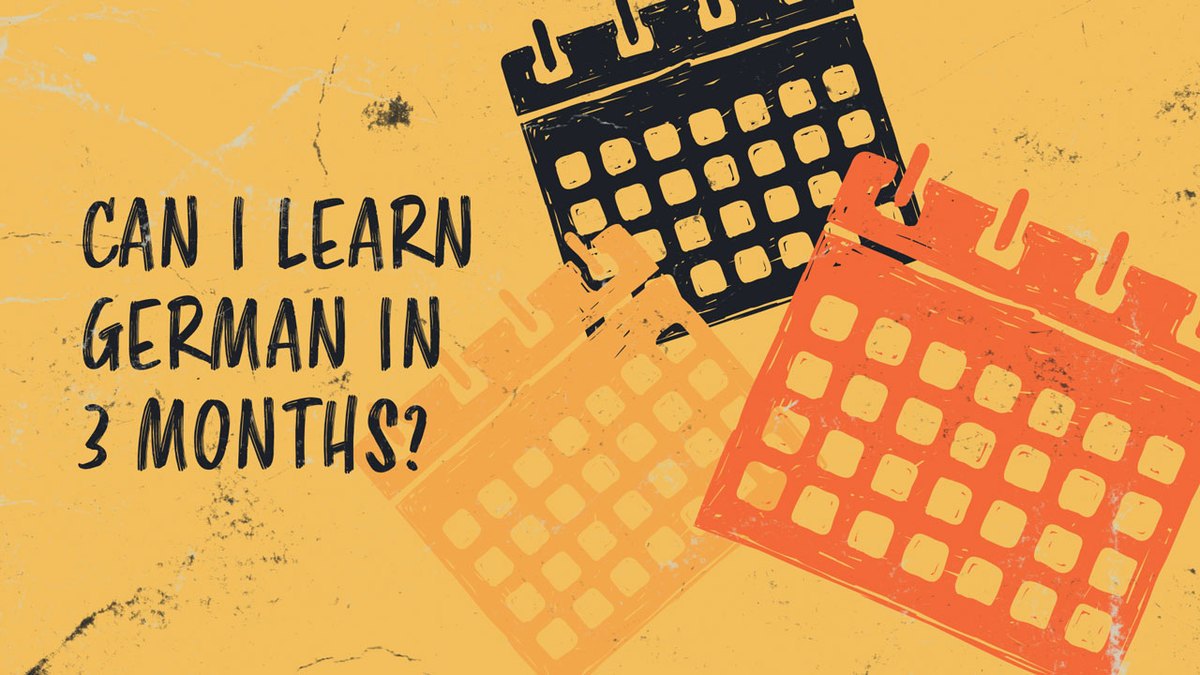Can You Learn German in 3 months? Here’s How I Did It
How long does it take to learn German? Learning German doesn’t have to be hard.
Back in 2010, I went from a beginner level to near mastery in German in just 3 months. But I’m not a language genius, or a natural with languages.
I’ve revealed the techniques I’ve used to learn German in my in-depth guide Why German is Easy.
To create this guide, I took the “hardest” grammar and vocabulary points and presented them in a new way that shows you how you can learn German as quickly as possible.
Here’s a sneak peek of what’s inside.
Table of contents
This blog post is an extract from my language hacking guide Why German is Easy, in which I sum up everything I learned by learning to speak German in 3 months.
German Is Easy
If languages came “naturally” to me, then I would have aced German the first time round.
I didn’t.
I spent five years studying German at high school, and I got a C as my final grade. The worst is that I couldn’t even order a train ticket in German when I visited Munich a few years ago.
After I became fluent in my first four languages, I decided to give German a second attempt. I aimed to be a fluent German speaker in just three months.
After just three months of living in Germany, I passed four out of five sections of Goethe Institut’s Zentrale Oberstufenprüfung (German mastery exam).
What changed? I stopped telling myself how hard German was and started focusing on the positive. Creating a positive filter made the language easy for me.
Yes, you read that right. German can be easy.
This isn’t about fooling yourself with empty mantras or willing the universe to make it easy for you. There are very logical and systematic ways of looking at German to make sure that you keep this positive feedback loop up and make swift progress in the language.
The Easy Way to Pluralise Words in German

If you want to learn German fast, here’s a big question you’ll ask yourself:
Why can’t German just add ‘s’ for plurals like in English?
This question comes up a lot, but it ignores the many irregular plurals we have in English, too.
By far the most common plural ending for feminine nouns in German (and occasionally for some masculine or neuter ones) is –n or –en. This sounds familiar when you look at certain English words, like “ox/en” and “child/ren”.
In English, we actually did this quite a lot in the past! The archaic/poetic word brethren, now used in fraternal order, actually used to be the standard plural form of “brother” (initially written brether).
This is even more evident in word root changes. For example, English has “foot”/”feet”, “(wo)man”/”men”, “tooth”/”teeth”, “mouse”/”mice”, “goose”/”geese”. This is actually more complicated than the German equivalent of adding an umlaut and no ending or –e/-er endings in words like Hand/Hände, Wand/Wände, Nacht/Nächte, Apfel/Äpfel, Vater/Väter.
Once again, it’s ordinarily suggested that you simply learn the plural as you learn the word. So theoretically, every time you meet a new word you’d have to learn the gender, the plural, and the word itself, as well as any special case declensions. Phew, sounds exhausting!
This is not a practical solution, especially for beginner to intermediate learners who have many other things to worry about. So once again, I recommend you use some short cuts!
9 Simple Shortcuts for German Plurals
One of the books for German learners that I highly recommend Hammer’s German Grammar and Usage by Martin Durrell, and in the book the author shares some very helpful statistics. I’ll share the most important ones below, but keep in mind that you shouldn’t try to memorise these right now, just use them for reference to help you understand the simple rule of thumb I’ll introduce.
Masculine:
- Most masculine nouns have a plural in -e or ¨e. The umlaut goes over about half of the nouns where it would be possible (i.e. not over i or e), g. Arm/Arm(e), Hund/Hund(e), Fuß/Füß(e), Stuhl/Stühl(e).
- Most masculine nouns ending in -el, -en, or -er form their plural without an ending or umlaut, g. Onkel, Bäcker, Computer (same in singular and plural).
- A small number of masculine nouns have the plural -en or -n, especially “weak nouns” (see any grammar book explanation for what this means).
Feminine:
- Over 90% of all feminine nouns have the plural -en/-n, g. Arbeit(en), Regel(n), Studentin(nen) (the last n gets doubled for -in ending nouns).
- About a quarter of feminine monosyllables have a plural in ¨e, g. Hand/Händ(e), Nacht/Nächt(e), Stadt/Städt(e), etc.
Neuter:
- About three quarters of neuter nouns have the plural -e, e.g. Bein(e), Jahr(e).
- Slightly less than a quarter of neuter nouns have the plural ¨er/-er. The umlaut is used if possible and the majority are either mon- osyllabic, e.g. Dorf/Dörf(er), Kind/Kind(er), or start with ‘Ge’, e.g. Gesicht(er), Gehalt(er), Geschlecht(er).
- Neuter nouns ending in -el, -en, -er (note that this is the same as for masculine); diminutives ending in -chen, -lein; and words formed with …e all have the same plural as the singular form, e.g. Mädchen, Gebäude, Messer, Kissen.
- -s is used with many recent loan-words from English or French: Chef(s), Hotel(s), Restaurant(s), Team(s), Tunnel(s), and for abbreviations like LKW(s) and for most words ending in a vowel other than unstressed -e: Auto(s), Genie(s)
There are other possibilities and very occasional exceptions. However, these rules cover the vast majority of the nouns you will ever come across in German.
Ideally, you would learn the proper plural of nouns as you come across them, but since this may not be practical if your priority is to communicate as much as possible in a short time, you will, once again, be better off guessing.
How to Use These Rules-of-Thumb for Guessing German Plurals
Learning off precise plurals should also be low priority when compared to learning new vocabulary or more important aspects of grammar.
This is another situation where I can confirm from personal experience that Germans will understand you perfectly well if you use the wrong plural. Just like if a beginner English learner said to you that he saw six “mouses”, it would sound a little weird, but you would understand it no problem.
In an academic examination you would lose points for writing down the wrong plural. However, with human beings you will gain points for actually saying something, rather than keeping your mouth shut for fear of saying it wrong.
Based on the statistics above, you have a pretty decent chance at guessing the correct plural! The most common ending is -e, so try this one first. If the singular already ends in -e, it is slightly more likely to be feminine so add an -n.
Use this rule of thumb, then try to learn the above list, and finally get feedback from natives and spend more time reading, and you will quickly see the exceptions.
As always, this is not a perfect solution. But saying a word in what sounds like plural will get you further. The context and use of numbers or die (genderless plural article, even though it’s the same as the feminine article) will make it much clearer that you mean plural.
Can You Really Learn German in 3 Months?
Like I said earlier in the post, this blog post is an extract from my language hacking guide Why German is Easy.
(Psst… Pick up your own copy here!)
I learnt German in 3 months. It is a mission totally possible.
In fact, it’s a mission that many Fluent in 3 Months Challengers have taken up. And they have succeeded! Here’s an example:
The Fi3M Challenge guides beginners in any language to have a 15-minute conversation with a native speaker after only 90 days.
If you want to give it a try, you can check out my list of the best online resources to learn German over here!



Social